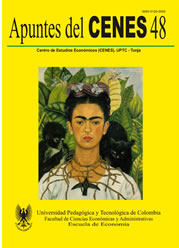La ciudad calidoscópica

Resumen
Este artículo es una búsqueda que consiste en saber si sería posible pensar la emergencia de una configuración espacial (orden espacial) con fundamento en el discurso de la economía, esto es, teniendo en cuenta solamente las elecciones individuales y descentralizadas de localización cuyo mecanismo de coordinación sería el mercado. Con este propósito, estudiaré en un primer momento el abordaje neoclásico que presenta un orden (equilibrio) espacial único, estable y eficiente, en seguida, propondré un camino alternativo,heterodoxo, donde el orden espacial que resulta de la coordinación mercantil surge, antes, como pertinente a una estructura caleidoscópica cuya frontera entre el orden y el desorden del uso del suelo urbano es opaca y mutante. Es también mí propósito desarrollar un discurso heterodoxo tomando por base ciertas dificultades (y temas) con que se depara la ortodoxia espacial, cuando las elecciones son intertemporales e interdependientes. Conviene señalar que asumimos siempre el discurso de la economía sobre las relaciones mercantiles,por tanto, las nociones y las conclusiones mencionadas están fuertemente ligadas a esta opción inicial.
ABSTRACT:
This article is a search that is whether it would be possible to consider the emergence of a spatial configuration (spatial arrangement) on the basis of the discourse of the economy, that is, taking into account only individual choices and location decentralized coordination mechanism which would be the market. To this end, I will study at first the neoclassical approach that presents an order (balance) sole space, stable and efficient at once, I will propose an alternative way, heterodox, where the spatial order resulting from the commercial coordination arises, before, as relevant to a kaleidoscopic structure whose border between order and disorder of urban land use is opaque and mutant. It is also my intention to develop a heterodox discourse by drawing some difficulties (and themes) with orthodoxy holds that space, where choices are intertemporal and interdependentes. Always assumed to be noted that the speech of the economy on market relations, so the concept and the above findings are closely tied to this original.
Palabras clave
Orden espacial, política urbana, mercado residencial. (spatial order, urban policy, residential market)
Referencias
- ABRAHAM-FOIS, G. (1980): Rente, rareté et surprofits, París, Económica.
- ABRAMO, P. (1994): Le marche, lordredésordre et la coordination spatiale, París, E.H.E.S.S., tesis de Doctorado.
- ABRAMO, P. (1997): Marché et ordre urbain: du chaos à la théorie de La localisation résidentielle, París, Harmattan.
- AGLIARDI, E. (1988): “Microeconomic foundations of macroeconomics in the postkeynesian approach”, Metroeconómica, 39, 275- 297.
- AGLIETTA, M. et ORLÉAN, A. (1982): La violence de la monnaie, PUF, París.
- AKERLOF, G. and YELLEN, J. (1985): “A near-rational model of the business cycle, with wage and price inertia”, Quaterly Journal of Economics, 100, supl., 823-838.
- ALONSO , W. (1972): “A theory of urban land market”, Edel and Rothenberg eds (1972).
- AMADEO , E.J. and DUTT, K. (1991): “A post Keynesian theory of growth, interest and money”, Department of economics – PUC/RJ, junio.
- ANAS, A. (1978): “Dinamics of urban residential growth”, Journal of Urban Economics, 5, 66-87.
- ANAS, A. y DENDRINOS, D. (1976): “The new urban economics: a brief survey” en Papageorgiou, ed (1976).
- ARENA, R. (1985): “Rationalité microéconomique et circulation marcoéconomique: Keynes et Shumpeter”, Cahier d’economie politique, 10-11, 149-168
- ARESTIS, P. (1988): “Post-Keynesian theory of money, credit and finance” en Arestis, P ed. (1988): Post-Keynesian monetary economics: new directions in modern economics, Edward Elgar.
- ARNOTT, R., DAVIDSON, R. y PINES, D. (1986): “The spatial aspect of housing quality, quantity and maintenance”, Journal of Urban Economics, 19, 190-217.
- ASIMAKOPULOS, A. (1985): “Keynes and Sarffa: visions and perspectives”, Political Economy, 1, 33-50.
- BAILEY, M. (1959): “Note on the economics of residential zoning and urban renewal”, Land Economics, 35, 288-292.
- BANSOR, R. (1983): “The rational-expectation hypothesis and the epistemics of time”, Cambridge Journal of Economics, 7, 1-10.
- BARNES, T. J. (1989): “Place, space theories of economic value: contextualism and essentialism in economic geography”, Transaction; Institute of British Geographers, 14, 299-316.
- BARRÈRE, A. (1985): “Les fondoments de l’economie monétaire de production” en Barrère, A. ed (1985): Keynes aujourd’hui, Económica, París.
- BASILA, L. (1989): “L’incertezza nella teoría economiche. Une prospectiva epistemológica”, Richerchi Economiche, 218-235.
- BECKMANN, M. J. (1969): “On the distribution of urban rent and residential density”, Journal of Economic Theory, 1. 60-67.
- BENETTI,C. y CARTELIER, J. (1980): Marchands, salariat et capitalistes, Maspero, París.
- BERLIANT, M. (1984): “A characterization of the demand for land”, Journal of Economic Theory, 33, 289-300.
- BROWN, B. (1985): “Models of land use, housing and rent: an evaluation”, Journal of Urban Economics.
- CAILLÉ, A. (1993): La demission des clercs: la crise des sciences socials et l’oubli du relativisme”, Revue u MAUSS, 1, 122-153.
- CALDWELL, B. J. (1989): “Post-Keynesian methodology: an assessment”, Review of Political Economy, marzo.
- CARTELIER, J. (1985): “Théorie de la valeur ou hétérodoxie monétaire: les termes d’un choix”, Economie Appliquée.
- CARVALHO, F. J. C. (1988): “Keynes, a instabilidade do capitalismo e a teoria dos ciclos econômicos”, Pesquisa e Planejamento Econômico, 18, 741-764.
- CASTELLS, M. (1972): La question urbaine, Maspero, París.
- CHICK, V. (1983): Macroeconomic after Keynes: a reconsideration of the General Theory, Phiplip Allan, Oxford.
- CLAVAL, P. (1987): “Le neo-marxiste et l’espace”, L’espace geographique, XVI, 3.